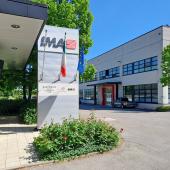The consumer revolution as interpreted by…
Representatives of various food & beverage firms spoke at the ACIMGA conference, but also those in the packaging sector (producers of paper and board, flexible packaging and labels) and vending machine operators, who interpreted the changes reported by the experts and offered some innovative proposals. Their success is proof of the accuracy of their findings.
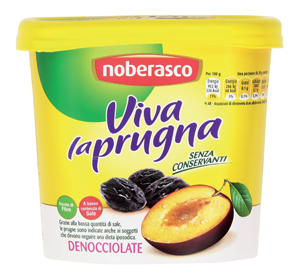 Noberasco: from dried fruit to snacks. Mattia Noberasco, managing director of the Ligurian company of the same name, recounted the experience of converting dried and dehydrated fruit from a dying commodity into a snack for every occasion. The crucial steps of this success story were: downplaying negative associations - the “W la prugna” brand dissociates the image of the fruit from its grudging use as a laxative; de-seasonalized consumption and story-telling (the packaging promises exotic fruits with properties to discover); multiplication of opportunities for consumption (snacks, sweet tooth, breakfast…) and thus also distribution channels. And then initiatives to intercept and identify consumers: the temporary shop at Milan’s Garibaldi Station, which has snagged rushing travelers with small on-the-go packaging formats, the opening of single brand stores with countless opportunities for individual contact, the orientation toward paper packaging, with added service and that “speaks”, and more.
Noberasco: from dried fruit to snacks. Mattia Noberasco, managing director of the Ligurian company of the same name, recounted the experience of converting dried and dehydrated fruit from a dying commodity into a snack for every occasion. The crucial steps of this success story were: downplaying negative associations - the “W la prugna” brand dissociates the image of the fruit from its grudging use as a laxative; de-seasonalized consumption and story-telling (the packaging promises exotic fruits with properties to discover); multiplication of opportunities for consumption (snacks, sweet tooth, breakfast…) and thus also distribution channels. And then initiatives to intercept and identify consumers: the temporary shop at Milan’s Garibaldi Station, which has snagged rushing travelers with small on-the-go packaging formats, the opening of single brand stores with countless opportunities for individual contact, the orientation toward paper packaging, with added service and that “speaks”, and more.
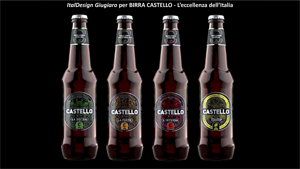 Pedavena and “physital” packaging.
Pedavena and “physital” packaging.
Birra Castello Pedavena Dolomiti’s commitment to engaging the consumer was explained by Febo Leondini, an advisor to the company, who spoke about the bottle designed by Giugiaro, with a QR code that directs users to the company’s partnership with the Ministry of Environment for carbon footprint and raw materials traceability, but also about reinventing the products’ identity: no longer blonde and red beers, but “strong” and “intense”… and of numerous initiatives to valorize the land’s resources.
Particularly striking are the concern’s efforts to turn breweries into large “containers”, both physical and digital (“physital”), in which each consumer with the dedicated app can be recognized and welcomed just as they like.
The system knows their tastes and learns more all the time, enhancing not only its communicative function but also the ability to “listen” of a packaging that becomes a medium of both atoms and bits.
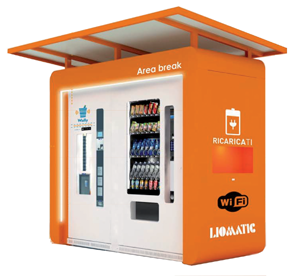 Liomatic, or meta-packaging. The idea of vending as Internet - ever present, everywhere and with every kind of product - is made a reality in a vending machine that Ilaria Caporali (CEO Liomatic) describes as a large polyvalent container: recognizable as such and adaptive, moving from its indoor origins outside, exponentially expanding its horizons. In the meantime, it has also changed its indoor function, where it shines as a place for socializing and has thus been repositioned (away from the WC!) and accessorized (waste bins, defibrillators, phone and tablet chargers…)
Liomatic, or meta-packaging. The idea of vending as Internet - ever present, everywhere and with every kind of product - is made a reality in a vending machine that Ilaria Caporali (CEO Liomatic) describes as a large polyvalent container: recognizable as such and adaptive, moving from its indoor origins outside, exponentially expanding its horizons. In the meantime, it has also changed its indoor function, where it shines as a place for socializing and has thus been repositioned (away from the WC!) and accessorized (waste bins, defibrillators, phone and tablet chargers…)
Speed and service are the heart of this particular “distribution channel”, which, Caporali stresses, still presents enormous potential, including as an “ear”: the vending machine can tell the brand owner where and at what time each product is consumed, and in combination with what. This listening function is being progressively refined to enhance recognition and identification of individual users, capacity for customized offer, targeted promotion, etc.
This system goes hand in hand with the creation of a packaging portioned and structured ad hoc, and “programmed” to make possible this dialog between man, machine and manufacturer.
 Pedon: what beans? No longer the poverty food that takes forever to cook, but a healthful, traditional ingredient, a base for delicious and balanced meals, finally made accessible by shortened cooking time.
Pedon: what beans? No longer the poverty food that takes forever to cook, but a healthful, traditional ingredient, a base for delicious and balanced meals, finally made accessible by shortened cooking time.
That’s what Pedon offers new consumers. The concern was represented at the conference by marketing manager Luca Zocca. The crucial factors in Pedon’s business: service (quick cooking times compatible with other ingredients, single portions, packaging for on-the-go eating, reclosable packaging…), a capacity for story-telling (the product’s origin, tradition, recipes…), social responsibility and environment (supporting humanitarian projects, developing eco-sustainable packaging solutions like the one created with Favini and Lucaprint), product innovation (mix of ingredients, products fortified with additional nutrients…).
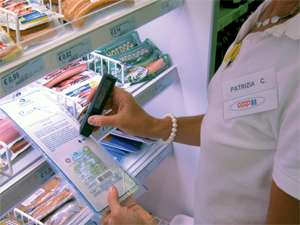 Cold-Pharma: a smart label for freshness. Cold-Pharma developed Blueline to monitor the cold chain, identify any interruptions and verify damages in order to execute immediate corrective action. It’s not a thermochromic label but an original and patented system based on a “hyphen” printed on the label with a special magnetic ink that functions as a heat sensor. It is scanned by a corresponding device and can be hooked up to a PDA for data collection.
Cold-Pharma: a smart label for freshness. Cold-Pharma developed Blueline to monitor the cold chain, identify any interruptions and verify damages in order to execute immediate corrective action. It’s not a thermochromic label but an original and patented system based on a “hyphen” printed on the label with a special magnetic ink that functions as a heat sensor. It is scanned by a corresponding device and can be hooked up to a PDA for data collection.
 Oltremare: from jute to RFID. At Oltremare (custom services, machines and lines for processing and packaging industrial food products), safeguarding hygiene and stock integrity means replacing traditional jute bags with flexible modified atmosphere vacuum containers that prevent bacteria and molds. By attaching a microchip to each unit, it is possible to track products always and everywhere.
Oltremare: from jute to RFID. At Oltremare (custom services, machines and lines for processing and packaging industrial food products), safeguarding hygiene and stock integrity means replacing traditional jute bags with flexible modified atmosphere vacuum containers that prevent bacteria and molds. By attaching a microchip to each unit, it is possible to track products always and everywhere.
RELATED ARTICLES: "We eat what we want to be"












